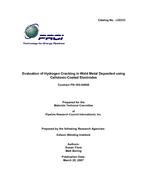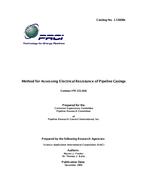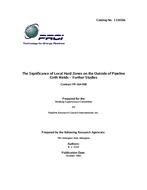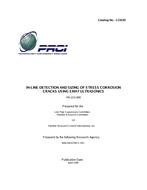Provide PDF Format
PRCI PR-185-04508
- Evaluation of Hydrogen Cracking in Weld Metal Deposited using Cellulosic SMAW Electrodes
- Report / Survey by Pipeline Research Council International, 10/17/2006
- Publisher: PRCI
$25.00$50.00
L52233e
Edison Welding Institute
Need: Cellulosic-coated electrodes (primarily AWS EXX10-type) are traditionally used for "stovepipe" welding of pipelines because they are well suited for deposition of pipeline girth welds and are capable of high deposition rates when welding downhill. Despite advances in mechanized welding technology, development of low-hydrogen self-shielded flux-cored arc welding (FCAW) consumables, and substantial improvement of basic-coated low-hydrogen vertical-down shielded metal arc welding (SMAW) electrodes, manual pipeline welding using cellulosic-coated electrodes is still widely utilized throughout the world. Cellulosic-coated electrodes are also used for critical applications in offshore pipeline construction such as tie-in welds and repair welds.
Hydrogen-assisted cracking can occur in both the weld metal and heat-affected zone (HAZ) regions of a welded joint, although HAZ hydrogen cracking is more common. Extensive work was undertaken in the 1970s and 1980s to study HAZ hydrogen cracking, and guidelines were developed to avoid HAZ hydrogen cracking by controlling heat input and preheat. Improvements in steelmaking practice and the trend toward leaner chemistries have also helped to alleviate HAZ hydrogen cracking.
Result: The primary objectives of this project are to further define the conditions that can lead to hydrogen cracking in weld metal deposited using cellulosic-coated electrodes, in terms of operator preference (arc length), electrode properties, power supply selection, and materials handling. The results of the project are being used to develop welding guidelines, and if applicable, re-hydration guidelines to prevent weld metal hydrogen cracking.
Benefit: An extensive study involving a variety of manufacturers' cellulosic-coated electrodes in strength levels ranging from 60 to 90 ksi has allowed the conditions that can lead to hydrogen cracking in weld metal to be further defined. Specifically operator preference (arc length), electrode properties, power supply selection, and materials handling were examined. The effect of re-hydrating the electrodes was also studied. The results of the project have been used to develop safe handling guidelines.
Edison Welding Institute
Need: Cellulosic-coated electrodes (primarily AWS EXX10-type) are traditionally used for "stovepipe" welding of pipelines because they are well suited for deposition of pipeline girth welds and are capable of high deposition rates when welding downhill. Despite advances in mechanized welding technology, development of low-hydrogen self-shielded flux-cored arc welding (FCAW) consumables, and substantial improvement of basic-coated low-hydrogen vertical-down shielded metal arc welding (SMAW) electrodes, manual pipeline welding using cellulosic-coated electrodes is still widely utilized throughout the world. Cellulosic-coated electrodes are also used for critical applications in offshore pipeline construction such as tie-in welds and repair welds.
Hydrogen-assisted cracking can occur in both the weld metal and heat-affected zone (HAZ) regions of a welded joint, although HAZ hydrogen cracking is more common. Extensive work was undertaken in the 1970s and 1980s to study HAZ hydrogen cracking, and guidelines were developed to avoid HAZ hydrogen cracking by controlling heat input and preheat. Improvements in steelmaking practice and the trend toward leaner chemistries have also helped to alleviate HAZ hydrogen cracking.
Result: The primary objectives of this project are to further define the conditions that can lead to hydrogen cracking in weld metal deposited using cellulosic-coated electrodes, in terms of operator preference (arc length), electrode properties, power supply selection, and materials handling. The results of the project are being used to develop welding guidelines, and if applicable, re-hydration guidelines to prevent weld metal hydrogen cracking.
Benefit: An extensive study involving a variety of manufacturers' cellulosic-coated electrodes in strength levels ranging from 60 to 90 ksi has allowed the conditions that can lead to hydrogen cracking in weld metal to be further defined. Specifically operator preference (arc length), electrode properties, power supply selection, and materials handling were examined. The effect of re-hydrating the electrodes was also studied. The results of the project have been used to develop safe handling guidelines.
Related Products
PRCI PR-185-04500
Ultrsonic Inspection of Hot Tap Branch Connections and Weld Sleeve-Fillet Weld using Phased Arrays..
$98.00 $195.00
PRCI PR-164-008
The Significance of Local Hard Zones on the Outside of Pipeline Girth Welds - Further Studies..
$98.00 $195.00
PRCI PR-155-909
In-Line Detection and Sizing of Stress Corrosion Cracks Using EMAT Ultrasonics..
$125.00 $249.00





